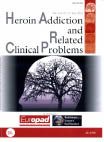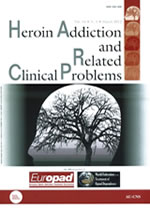How to submit an article
Submission: click here to login and submit an article
2023 Impact factor (JCR Clarivate): 0.8;
2023 Scopus CiteScore: 1.6
Instructions for Authors
Heroin Addiction and Related Clinical Problems publishes Editorials, Regular Articles, Short Reviews, Reviews, Preliminary Communications, Short Communications, Reports, Expert Opinions, Case Reports, and Letters to the Editor on subjects regarding heroin addiction and related clinical problems. Heroin Addiction and Related Clinical Problems is particularly interested in therapies, including all aspects of translation from bench to bedside: identification of novel therapeutic targets, epidemiology, clinical trials, drug safety and meta-analyses. Reviews should include systematic literature revision concerning the topics treated and meta-analyses. Short reviews are dedicated to particular aspects of heroin addiction. Heroin Addiction and Related Clinical Problems accepts for publication only unpublished data. The structured abstract must not exceed 300 words.
Manuscript Submissions
Authors should submit manuscripts, including figures, to the Heroin Addiction and Related Clinical Problems website using exclusively the downloadable form. Papers must be submitted solely to the Journal and accepted because they have not been published elsewhere and will not be. The submission process requires a full declaration of the personal interests of all Authors and funding interests by the presenting author; these details should also be included in the manuscript's text. By submitting your manuscript to the journal, you accept that your manuscript may be screened for plagiarism.
Authorship
Each author must fulfil the following criteria:
- They must have contributed substantially to research design or data acquisition, analysis, or interpretation.
- They must have drafted the paper or revised it critically.
- They must have approved the submitted and final versions.
Copyright Transfer Agreement: Heroin Addiction and Related Clinical Problems: Authors must NOT sign a copyright declaration. The Editors retain the usual right to modify the style and length of a contribution (significant changes being agreed with the corresponding Author) and decide the publication time.
Illustrations
For production purposes, you must supply every figure in A4 .pdf format (minimum 300 dpi). Figure and table legends must be able to stand alone in the text; thus, full descriptive legends for all figures and tables should be supplied.
Statistics
Methods should be referenced. Two-tailed significance tests should be used unless explicitly stated otherwise. Controls should be described as entirely as experimental subjects. Measures of location should be accompanied by variability (e.g. mean and confidence intervals) and conventional probability values. Clinical trial reports should include the power of the study design.
Acknowledgements
Some examples are:
- All authors were involved in the literature review, critically reviewed the manuscript, had full editorial control, and were ultimately responsible for the decision to submit the paper for publication.
- All authors were involved in the study design, had full access to the survey data and analyses, interpreted the data, critically reviewed the manuscript and had full control, including final responsibility for the decision to submit the paper for publication.
Role of the funding source
Some examples are:
- This study was funded [in part or in whole] by [insert name of funding organisation], grant number [insert grant or other identification number].
- This paper's [writing or preparation] was funded in part by [insert name of funding organisation].
- Initial data analyses were undertaken by [name of individuals if not listed as Authors] who are employees of [name company] and received funding from [insert name of funding organisation].
- Writing support was provided by [insert name of individual(s)] of [name company] and funded by [insert name of funding organisation].
Ethics
An Ethics Committee should have approved human and animal studies, but the Editors reserve the right to reject papers in questionable matters.
Authors must confirm that the submitted study was conducted according to the WMA Declaration of Helsinki - Ethical Principles for Medical Research Involving Human Subjects. If the study was carried out according to a non-interventional protocol, it does not require ethics committee approval.
In all cases, all patients must give their informed consent to the anonymous use of their clinical data.
Conflict of Interest
Sources of financial support during the last two years must be acknowledged. Please read the following statements, adding relevant sections at the end of your submitted manuscript under the heading ‘Conflict of interest.
Some examples are:
- The authors declared no conflict of interest.
- [Name of individual] has served as a speaker, a consultant, and an advisory board member for [names of organisations] and has received research funding from [names of organisation].
- [Name of individual] is an employee of [name of organisation].
- [Name of individual] owns stocks and shares in [name of organisation].
- [Name of individual] owns patent [patent identification and brief description].
References
References must be ordered alphabetically by authors’ names. Start each reference with a bibliography number; use these numbers in squared parentheses for in-text citations. Personal communications, unpublished manuscripts, submitted but not yet accepted, and similar unpublished items should not appear in the reference list. Such citations may be noted in the text.
Please use the following guidelines for arranging references:
-
Journal article:
Maremmani A. G. I., Rovai L., Maremmani I. (2012): Heroin addicts' psychopathological subtypes. Correlations with the natural history of illness. Heroin Addict Relat Clin Probl. 14(1): 11-22. -
Book:
Tagliamonte A., Maremmani I. (1995): Drug Addiction and Related Clinical Problems. Springer-Verlag, Wien, New York. -
Book Chapter:
Dole V. P. (1995): Methadone Maintenance. Comes of Age. In: Tagliamonte A., Maremmani I. (Eds.): Drug Addiction and Related Clinical Problems. Springer-Verlag, Wien New York. pp. 45-49.
Journal names should be abbreviated as they appear in Index Medicus; journals not currently indexed there should not be abbreviated.
In organising references in the text, we strongly suggest using a “reference manager”, namely EndNote. Please insert the reference code in the article text, permitting us to export a travelling bibliography. On our website, you can download the EndNote style for Heroin Addiction and Related Clinical Problems to facilitate making a bibliography. Manuscripts must comply with these rules to be considered further.
The EndNotes© output file is downloadable at Heroin_Addiction.ens.
Drug Names
Generic names should, in general, be used. If an Author so desires, brand names may be inserted in parentheses. Drug names are spelt out according to the European Pharmacopoeia, but the American spelling should be used after the first use of a drug name.
Proofs
The corresponding Author will receive an e-mail with a PDF file (portable document format) of the proof. Acrobat Reader will be required to read the file. Excessive changes made by the Author in the proofs, excluding typesetting errors, will be charged separately.
Reprints
Heroin Addiction and Related Clinical Problems combines the characteristics of a fee-based and no-fee open-access journal (see cost of publication). Heroin Addiction and Related Clinical Problems is a scholarly journal available online to the reader without financial, legal, or technical barriers other than those inseparable from gaining access to the internet itself. Editorial coordination, editing, and printing of an article requires the author's payment (see publication cost).
Subsidised activities are financed voluntarily and by educational grants from the Association for the Application of Neuroscientific Knowledge to Social Aims (AU-CNS), a not-for-profit agency located in Pietrasanta, Lucca, Italy (www.aucns.org); those requiring additional costs are typically financed by money made available to researchers for that purpose by a public or private funding agency, as part of a research grant.
AUCNS was founded in Viareggio (Lucca) in 1994. It is a not-for-profit association aiming to promote the spread of scientific knowledge and its application to mental illness and substance abuse issues. AUCNS is involved in research and teaching activities and organising seminars, conferences and public debates with either scientific or popular audience targets. Among these, the most remarkable are the National Conference of Addictive Diseases, which is held in Italy every two years, The European Opiate Addiction Treatment Association (EUROPAD) Conference, which is held in various European towns every two years, and a EUROPAD satellite meeting within the American Opioid Treatment Association Conference (AATOD) in the USA, which is held once every 18 months. AUCNS directly cooperates with national and international associations based on everyday purposes and fields of interest and runs an editing activity comprising psychiatry and substance abuse textbooks.
Donations can be made to Support Europad Activities.
Journal Supplements
You can contact the Editor in Chief, Icro Maremmani, MD, at info@heroinaddictionrelatedclinicalproblems.org. Our team will be able to provide advice and quotations for journal supplements.
Cost of Publication
The articles are published in .pdf format with a fee of € 200.00 after acceptance. The fee covers the editorial expenses and the DOI registration fee. Printed versions of journal issues and articles can be obtained separately after negotiation with the editorial office.
Authors pay a one-time Article Processing Charge (APC) to cover the costs of peer review administration and management, professional production of articles in PDF, and dissemination of published papers in various venues and other publishing functions. There are no charges for rejected articles, submission charges, figures, or supplementary data. Some items (Editorials, Corrections, Addendums, Retractions, Comments, etc.) are published free of charge.
AU-CNS accept payments only in euros (EUR). Upon acceptance, the corresponding/submitting author will receive an e-mail with a link to pay the fees.
AU-CNS currently supports the following payment methods:
- Wire transfer
- Payment with a Credit Card
- Online Payment by PayPal
At: https://www.europad.org/become-a-member.php
APCs are payable within 5 to 10 business days.
Invoices are emailed shortly after acceptance to the payment contact provided by the authors. Only official invoices issued by AU-CNS are valid. We do not authorise any third party to collect the APCs. AU-CNS is the sole service provider and cannot be held liable for actions by third parties.

